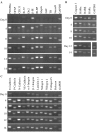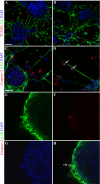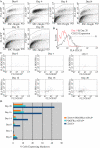Developmental cues and persistent neurogenic potential within an in vitro neural niche
- PMID: 20074373
- PMCID: PMC2824744
- DOI: 10.1186/1471-213X-10-5
Developmental cues and persistent neurogenic potential within an in vitro neural niche
Abstract
Background: Neurogenesis, the production of neural cell-types from neural stem cells (NSCs), occurs during development as well as within select regions of the adult brain. NSCs in the adult subependymal zone (SEZ) exist in a well-categorized niche microenvironment established by surrounding cells and their molecular products. The components of this niche maintain the NSCs and their definitive properties, including the ability to self-renew and multipotency (neuronal and glial differentiation).
Results: We describe a model in vitro NSC niche, derived from embryonic stem cells, that produces many of the cells and products of the developing subventricular zone (SVZ) and adult SEZ NSC niche. We demonstrate a possible role for apoptosis and for components of the extracellular matrix in the maintenance of the NSC population within our niche cultures. We characterize expression of genes relevant to NSC self-renewal and the process of neurogenesis and compare these findings to gene expression produced by an established neural-induction protocol employing retinoic acid.
Conclusions: The in vitro NSC niche shows an identity that is distinct from the neurally induced embryonic cells that were used to derive it. Molecular and cellular components found in our in vitro NSC niche include NSCs, neural progeny, and ECM components and their receptors. Establishment of the in vitro NSC niche occurs in conjunction with apoptosis. Applications of this culture system range from studies of signaling events fundamental to niche formation and maintenance as well as development of unique NSC transplant platforms to treat disease or injury.
Figures








Similar articles
-
Persistent Cyfip1 Expression Is Required to Maintain the Adult Subventricular Zone Neurogenic Niche.J Neurosci. 2020 Mar 4;40(10):2015-2024. doi: 10.1523/JNEUROSCI.2249-19.2020. Epub 2020 Jan 27. J Neurosci. 2020. PMID: 31988061 Free PMC article.
-
Assessing the Role of Ependymal and Vascular Cells as Sources of Extracellular Cues Regulating the Mouse Ventricular-Subventricular Zone Neurogenic Niche.Front Cell Dev Biol. 2022 Apr 5;10:845567. doi: 10.3389/fcell.2022.845567. eCollection 2022. Front Cell Dev Biol. 2022. PMID: 35450289 Free PMC article. Review.
-
Reconstituting vascular microenvironment of neural stem cell niche in three-dimensional extracellular matrix.Adv Healthc Mater. 2014 Sep;3(9):1457-64. doi: 10.1002/adhm.201300569. Epub 2014 Feb 12. Adv Healthc Mater. 2014. PMID: 24523050
-
Elements of a neural stem cell niche derived from embryonic stem cells.Stem Cells Dev. 2007 Dec;16(6):1017-26. doi: 10.1089/scd.2007.0012. Stem Cells Dev. 2007. PMID: 18047417
-
3D Reconstitution of the Neural Stem Cell Niche: Connecting the Dots.Front Bioeng Biotechnol. 2021 Oct 28;9:705470. doi: 10.3389/fbioe.2021.705470. eCollection 2021. Front Bioeng Biotechnol. 2021. PMID: 34778223 Free PMC article. Review.
Cited by
-
NXN Gene Epigenetic Changes in an Adult Neurogenesis Model of Alzheimer's Disease.Cells. 2022 Mar 22;11(7):1069. doi: 10.3390/cells11071069. Cells. 2022. PMID: 35406633 Free PMC article.
-
Collagen gel three-dimensional matrices combined with adhesive proteins stimulate neuronal differentiation of mesenchymal stem cells.J R Soc Interface. 2011 Jul 6;8(60):998-1010. doi: 10.1098/rsif.2010.0613. Epub 2011 Jan 19. J R Soc Interface. 2011. PMID: 21247946 Free PMC article.
-
Extracellular matrix: functions in the nervous system.Cold Spring Harb Perspect Biol. 2011 Jan 1;3(1):a005108. doi: 10.1101/cshperspect.a005108. Cold Spring Harb Perspect Biol. 2011. PMID: 21123393 Free PMC article. Review.
-
Composite Coatings Based on Recombinant Spidroins and Peptides with Motifs of the Extracellular Matrix Proteins Enhance Neuronal Differentiation of Neural Precursor Cells Derived from Human Induced Pluripotent Stem Cells.Int J Mol Sci. 2023 Mar 2;24(5):4871. doi: 10.3390/ijms24054871. Int J Mol Sci. 2023. PMID: 36902300 Free PMC article.
-
Current progress and challenges in the development of brain tissue models: How to grow up the changeable brain in vitro?J Tissue Eng. 2024 Mar 20;15:20417314241235527. doi: 10.1177/20417314241235527. eCollection 2024 Jan-Dec. J Tissue Eng. 2024. PMID: 38516227 Free PMC article. Review.
References
Publication types
MeSH terms
Grants and funding
LinkOut - more resources
Full Text Sources
Medical

